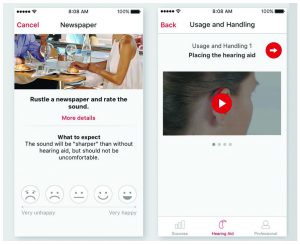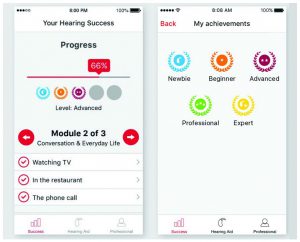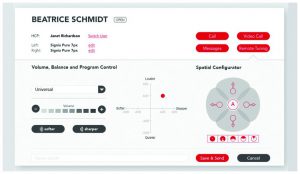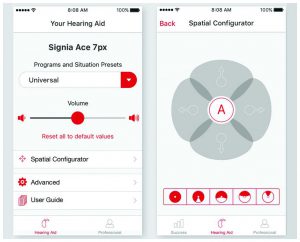Telehealth Apps and Hearing Aid Trial Periods: New Technology to Revolutionize Patient Care
Patricia Ramirez, AuD
The Hearing Review, November 29, 2016
Reused with permission from Hearing Review. All right reserved.
It’s no surprise that today’s hearing aid wearers want the latest technology in discreet form factors that complement their active connected lifestyle—and at a price they can afford. Technology, aesthetics, comfort, and price are all well-known factors in a patient’s decision to purchase and subsequently use amplification. Yet what may be some lesser known factors deal with the area of patient satisfaction. According to MarkeTrak 9,1 the top three drivers of patient satisfaction are:
1) Quality of service after the purchase;
2) Quality of counseling throughout the process, and
3) Quality of service during the fitting.
How can today’s hearing care professional (HCP) meet these expectations while differentiating their practice from the competition?
Trial Periods in a Void Lead to Disappointment, Rejection
Adapting to hearing aids can be a difficult process. It’s one of the reasons HCPs provide patients with a home trial period of 2 to 4 weeks before completing the purchase of hearing aids. This trial period requires patients to dedicate time and effort toward learning new technology, adjusting their daily routines, and setting appropriate expectations. Yet, during this most crucial phase of hearing care—when patients use hearing aids for the first time in their everyday life—they are largely expected to do the work on their own.
It’s obviously unrealistic to expect providers to be “on call” for their patients 24/7. However, during the trial period, many patients find themselves at a loss when faced with numerous challenges and questions, such as how to change batteries, why sounds are different than they expected, and which program to use in a given listening environment. This critical period of time can be referred to as a “blind spot” in hearing care that the HCP tends to have little control over. Consequently, the following situations can arise that, all too often, prevent a successful trial:
- Patients attend a follow-up appointment having rarely worn the hearing aids.
- They show little motivation to evaluate their hearing aids throughout the initial adoption period, and their feedback is usually not specific enough for the HCP to make the appropriate adjustments.
- They didn’t understand or remember the counseling they received about their hearing loss or how to correctly use their hearing aids.
- They are ultimately dissatisfied and return their hearing aids at the end of the trial period.
It’s thus no surprise that professionals are seeking new ways to address both the challenges and opportunities of the trial period. Thriving practices already know that providing the latest hearing technology, a superior level of service, and convenient access are all keys to practice success and happy patients. New advances in technology now provide a means to facilitate all of this, and many professionals should now consider the tools related to telemedicine or telehealth.
A New Innovation in Telehealth
In October 2016, Signia set out to address this blind spot with the introduction of TeleCare—the first solution of its kind designed to connect patients and HCPs during the all-important trial period and beyond. TeleCare consists of two components:
- The myHearing app, which is an intuitive smartphone app that patients can download for free via the App Store® or Google Play™.
- An easy-to-use, cloud-based web portal for professionals to stay in contact with patients that is accessible via any Internet browser. All information sent and received from the patient’s smartphone app is also recorded within this portal. The portal is automatic and adaptive, so it can be used on a desktop, laptop, tablet, or even smartphone.
How It Works
The HCP will typically have the patient download the myHearing app and connect to the professional’s portal right in the office. Once the patient downloads the myHearing app and the HCP logs into the portal, they are connected and can exchange information with security and privacy ensured via end-to-end encryption. Both the myHearing app and the professional portal are HIPAA compliant.
As part of the TeleCare solution, both the myHearing App and the professional portal work in concert to bring HCPs and patients closer together. Both the app and the portal contain several ways for HCPs to communicate and engage with new patients while providing a new level of patient care. These include:
 Figure 1. The Guided Assistance portion of the myHearing app includes listening exercises (left), and information about hearing aid usage and function (right).
Figure 1. The Guided Assistance portion of the myHearing app includes listening exercises (left), and information about hearing aid usage and function (right).Guided Assistance. The Guided Assistance program provides engaging step-by-step listening exercises and other assistance to help new wearers learn and adapt quickly to their hearing aids, promoting faster acclimatization (Figure 1). Throughout the process, the patient can earn “status badges” (eg, beginner, rookie, advanced, expert), while a progress bar lets them know how much of the training they have completed (eg, “You have completed 45% of the overall training journey”).
The HCP can define listening and usage tasks in the app to foster increased patient comfort and familiarity with new listening experiences and hearing aid usage. In addition, the app contains information about specific hearing aids functions, care and usage instructions including handling videos, as well as answers to frequently-asked-questions.
 Figure 2. Patients can complete listening exercises, earn status badges, and send feedback on their progress.
Figure 2. Patients can complete listening exercises, earn status badges, and send feedback on their progress.Personal Progress. The Personal Progress program enables structured wearer feedback on individual listening situations and overall ratings that provide valuable insights into a patient’s progression with hearing instruments (Figure 2). As wearers complete auditory training tasks, they are asked to rate their experiences, as well as overall daily satisfaction. This data becomes visible to the HCP via the professional portal, so they can identify issues and initiate contact, or prepare in advance for any office visits required to further fine-tune the hearing instruments.
CareChat. CareChat supports real-time text, audio, or video calls with patients to facilitate direct communication (Figure 3). The HCP can troubleshoot any problems quickly and efficiently, reducing time spent and frequency of in-person appointments.
 Figure 3. The Signia TeleLink feature allows HCPs to remotely adjust settings in the patient’s hearing aids.
Figure 3. The Signia TeleLink feature allows HCPs to remotely adjust settings in the patient’s hearing aids.This one-to-one chat system is comparable to Facebook Messenger, a familiar interface to most patients and HCPs. This way, many of their questions can be resolved without having to wait for the next follow-up appointment, which can be days or weeks away. With the secure professional portal, HCPs can monitor the status of their patient’s activities on the myHearing App anytime.
Signia TeleLink app. Perhaps the most significant feature, Signia TeleLink gives HCPs the ability to change selected parameters in their patients’ Signia hearing aids remotely, greatly improving the speed and convenience with which minor adjustments are made (Figure 3).
 Figure 4. The myHearing app also doubles as a hearing aid remote control.
Figure 4. The myHearing app also doubles as a hearing aid remote control.It also helps minimize disruptions to the initial adoption period and may reduce the need for follow up visits. HCPs can send new hearing aid setting adjustments directly via the professional portal to the myHearing app. Since the hearing aids and the patient app are wirelessly linked, the patient can try the proposed settings immediately.
Universal remote control. When used with Signia hearing instruments, the myHearing app also transforms the patient’s smartphone into a hearing aid remote control with adjustment options for volume, program, microphone focus, tone control, and tinnitus therapy volume (Figure 4).
It’s More than Just “Trial by Wearer”
Given the devastating implications of untreated hearing loss, every effort should be made to encourage adoption of hearing aids during the critical trial period. Research has shown that up to 27% of patients who were recommended hearing aids chose not to keep them after the trial period.2 Yet, for those who ultimately did purchase, the second and fourth most commonly cited reasons were, “Trusted the hearing care professional” and “The trial clearly showed hearing aids could improve hearing,” respectively.
These results illustrate both the importance of the HCP’s involvement and accessibility during the trial process, as well as the significance of the trial process itself. MarkeTrak VIII revealed that consumers wait on average 6.7 years before seeking treatment for hearing loss.1 Of those who try amplification, more than 1 out of 4 (many of whom already waited nearly 7 years), ultimately return the hearing aids during the trial. For wary consumers, a successful trial may be the difference between treatment resulting in a better quality of life, or the decision to permanently give up on hearing aids after the first try. HCPs who are actively involved in the trial process are in a better position to successfully deliver treatment and gain a customer for life.
Summary
Patient demand for quality of care coupled with technological innovations are changing today’s hearing healthcare business environment into a space increasingly focused on immediacy, constant connectivity, comfort, and a higher level of patient care. The Signia TeleCare platform offers HCPs unprecedented connectivity to their patients from first fitting through the trial period, and beyond.
TeleCare follows in the footsteps of other successful mHealth applications like diabetes monitoring, which has had its efficacy well-documented.3 Ongoing support ensures the new wearer not only continues enjoying all the benefits of amplification, but nurtures the all-important professional-patient relationship, which in turn leads to patient loyalty, repeat purchases, and referrals. The personal connection fostered by TeleCare saves time, increases quality of care, and drives conversion of patients into satisfied hearing aid wearers and long-term customers.
References
-
Kochkin S. MarkeTrak VIII: Reducing patient visits through verification and validation. Hearing Review. 2011; 18(6): 10-12
-
McCormack A, Fortnum H. Why do people fitted with hearing aids not wear them? Intl J Audiol. 2013; 52(5): 360-368.
-
Hamine S, Gerth-Guyette E, Faulx D, Green BB, Ginsburg AS. Impact of mHealth chronic disease management on treatment adherence and patient outcomes: A systematic review. J Med Internet Res. 2015; 17(2). Available at: https://www.ncbi.nlm.nih.gov/pubmed/25803266
